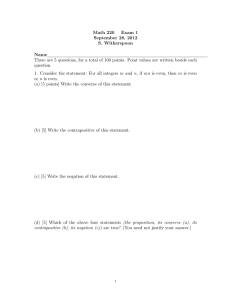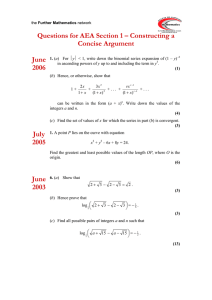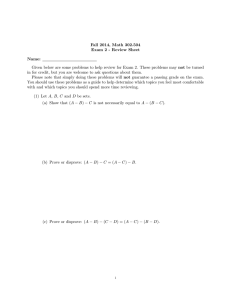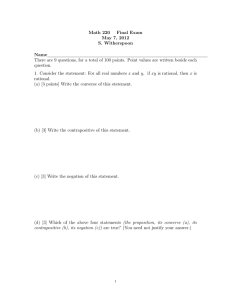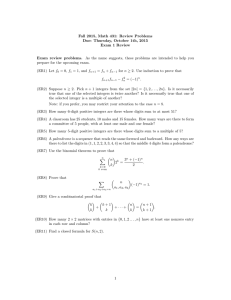Math 220 Exam 1 Sample Problems October 17, 2003
advertisement
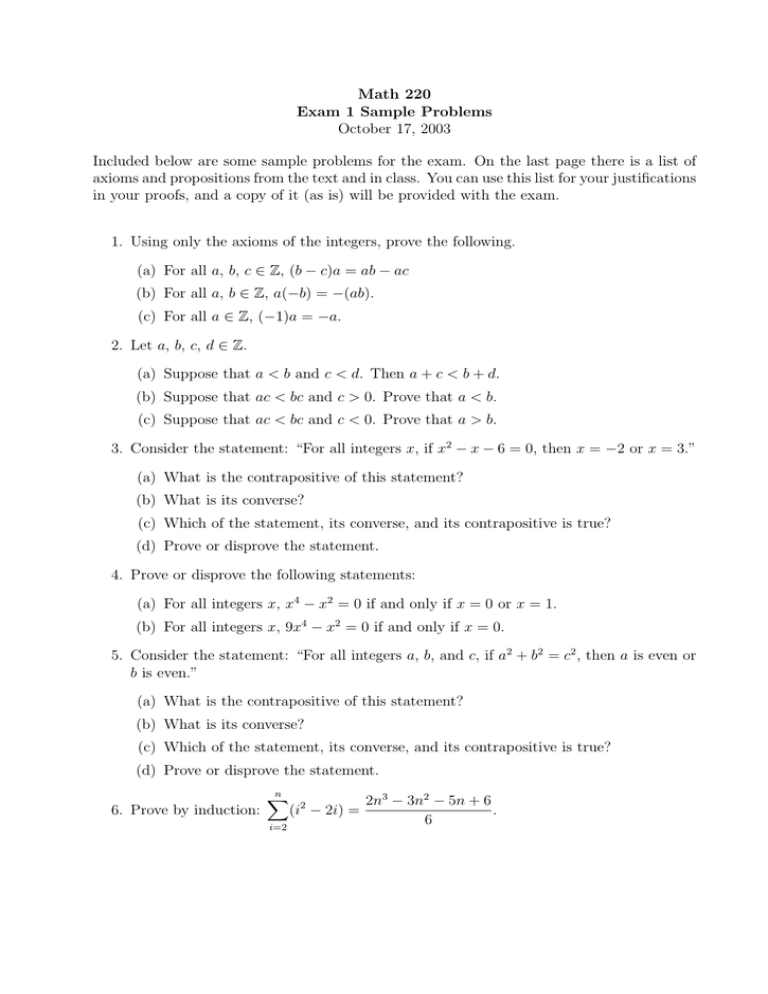
Math 220
Exam 1 Sample Problems
October 17, 2003
Included below are some sample problems for the exam. On the last page there is a list of
axioms and propositions from the text and in class. You can use this list for your justifications
in your proofs, and a copy of it (as is) will be provided with the exam.
1. Using only the axioms of the integers, prove the following.
(a) For all a, b, c ∈ Z, (b − c)a = ab − ac
(b) For all a, b ∈ Z, a(−b) = −(ab).
(c) For all a ∈ Z, (−1)a = −a.
2. Let a, b, c, d ∈ Z.
(a) Suppose that a < b and c < d. Then a + c < b + d.
(b) Suppose that ac < bc and c > 0. Prove that a < b.
(c) Suppose that ac < bc and c < 0. Prove that a > b.
3. Consider the statement: “For all integers x, if x2 − x − 6 = 0, then x = −2 or x = 3.”
(a) What is the contrapositive of this statement?
(b) What is its converse?
(c) Which of the statement, its converse, and its contrapositive is true?
(d) Prove or disprove the statement.
4. Prove or disprove the following statements:
(a) For all integers x, x4 − x2 = 0 if and only if x = 0 or x = 1.
(b) For all integers x, 9x4 − x2 = 0 if and only if x = 0.
5. Consider the statement: “For all integers a, b, and c, if a2 + b2 = c2 , then a is even or
b is even.”
(a) What is the contrapositive of this statement?
(b) What is its converse?
(c) Which of the statement, its converse, and its contrapositive is true?
(d) Prove or disprove the statement.
6. Prove by induction:
n
X
i=2
(i2 − 2i) =
2n3 − 3n2 − 5n + 6
.
6
7. Prove the following by induction. Suppose {a1 , a2 , a3 , . . .} is an infinite sequence of
integers such that a1 = 7, a2 = 13, and an = 2an−1 + 3an−2 for all integers n ≥ 3. Then
for all integers n ≥ 1, an = 5(3n−1 ) − 2(−1)n .
8. Write the coefficient of x8 y 9 in (2x − 3y)17 .
n
X
k n
9. Prove that
(−1)
= 0.
k
k=0
10. Let Z− = {−n | n ∈ Z+ } be the set of negative integers.
(a) Prove that −1 is the largest element of Z− .
(b) Explain why every nonempty subset of Z− has a largest element. (Formal proof
not required.)
(c) Prove that Z− is closed under addition bot not closed under multiplication.
Known Axioms and Propositions
Axioms of Z:
A0.
A1.
A2.
A3.
A4.
A5.
A6.
A7.
A8.
A9.
A10.
A11.
Closure of Z: Z is closed under + and ·.
Associtativity of +.
Commutativity of +.
0 is the additive identity element.
Every integer has an additive inverse.
Associativity of ·.
Commutativity of ·.
1 is the multiplicative identity element.
Distributive law. (Include a(b + c) = ab + ac and (b + c)a = ba + ca.)
Closure of Z+ .
Trichotomy law.
Well-ordering principle.
Let a, b, c ∈ Z.
P1.
P2.
P3.
P4.
P5.
P6.
P7.
P8.
Subtracting from both sides: a + b = a + c ⇒ b = c.
a · 0 = 0 · a = 0.
(−a)b = a(−b) = −(ab).
−(−a) = a.
(−a)(−b) = ab.
a(b − c) = ab − ac.
(−1)a = −a.
(−1)(−1) = 1.
Let a, b, c ∈ Z. Statements Q2–Q9 hold equally well if < is replaced by ≤ and > is replaced
by ≥.
Q1.
Q2.
Q3.
Q4.
Q5.
Q6.
Q7.
Q8.
Q9.
Exactly one of the following holds a < b, b < a, or a = b.
(a > 0 ⇒ −a < 0) and (a < 0 ⇒ −a > 0).
If a > 0 and b > 0, then a + b > 0 and ab > 0.
If a > 0 and b < 0, then ab < 0.
If a < 0 and b < 0, then ab > 0.
If a < b and b < c, then a < c.
If a < b, then a + c < b + c.
If a < b and c > 0, then ac < bc.
If a < b and c < 0, then ac > bc.
Other statements we have proved (in homework or in class).
R1.
R2.
R3.
R4.
R5.
∀a, b ∈ Z, −(a + b) = −a − b.
∀a, b ∈ Z, if ab = 0, then a = 0 or b = 0.
∀a, b, c ∈ Z, if ab = ac and a 6= 0, then b = c.
There is no integer x so that 0 < x < 1.
1 is the smallest element of Z+ .
